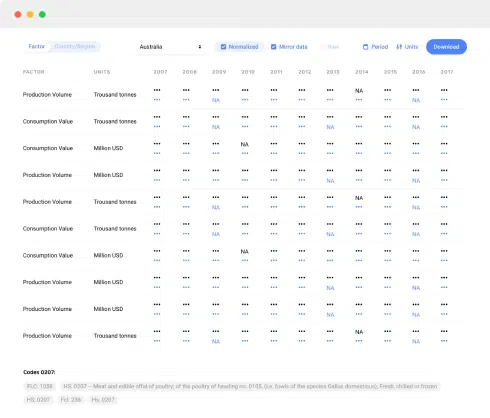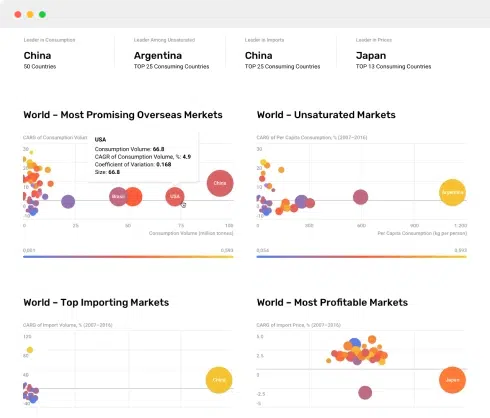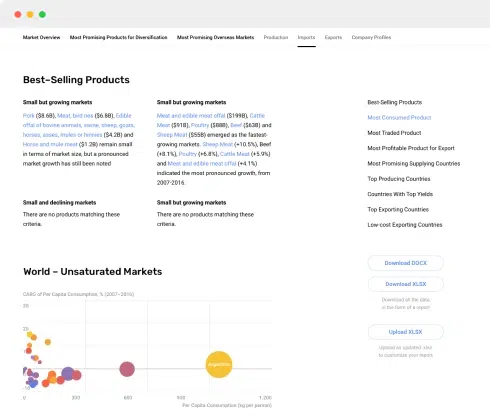
Singapore - Domestic Food Grinders and Mixers and Fruit or Vegetable Juice Extractors - Market Analysis, Forecast, Size, Trends and Insights
Get instant access to more than 2 million reports, dashboards, and datasets on the IndexBox Platform.
View PricingSingapore: Food Mixer Market 2025
Food Mixer Market Size in Singapore
The Singaporean food mixer market plummeted to $X in 2022, with a decrease of -25.9% against the previous year. Overall, consumption showed a relatively flat trend pattern. Food mixer consumption peaked at $X in 2014; however, from 2015 to 2022, consumption failed to regain momentum.
Food Mixer Production in Singapore
In value terms, food mixer production dropped dramatically to $X in 2022 estimated in export price. Over the period under review, production faced a dramatic contraction. Food mixer production peaked at $X in 2019; however, from 2020 to 2022, production failed to regain momentum.
Food Mixer Exports
Exports from Singapore
In 2022, the amount of domestic food grinders and mixers and fruit or vegetable juice extractors exported from Singapore shrank dramatically to X units, waning by -56.3% against 2021. Over the period under review, exports faced a abrupt decline. The most prominent rate of growth was recorded in 2017 when exports increased by 30%. As a result, the exports attained the peak of X units. From 2018 to 2022, the growth of the exports remained at a somewhat lower figure.
In value terms, food mixer exports dropped significantly to $X in 2022. Overall, exports recorded a abrupt downturn. The pace of growth was the most pronounced in 2013 with an increase of 23% against the previous year. As a result, the exports attained the peak of $X. From 2014 to 2022, the growth of the exports remained at a somewhat lower figure.
Exports by Country
Vietnam (X units) was the main destination for food mixer exports from Singapore, with a 41% share of total exports. Moreover, food mixer exports to Vietnam exceeded the volume sent to the second major destination, Cambodia (X units), fourfold. The United Arab Emirates (X units) ranked third in terms of total exports with a 6.7% share.
From 2012 to 2022, the average annual growth rate of volume to Vietnam amounted to -8.8%. Exports to the other major destinations recorded the following average annual rates of exports growth: Cambodia (-2.9% per year) and the United Arab Emirates (+39.4% per year).
In value terms, Vietnam ($X) remains the key foreign market for domestic food grinders and mixers and fruit or vegetable juice extractors exports from Singapore, comprising 39% of total exports. The second position in the ranking was held by Cambodia ($X), with a 9.3% share of total exports. It was followed by Indonesia, with a 7.2% share.
From 2012 to 2022, the average annual rate of growth in terms of value to Vietnam totaled -9.4%. Exports to the other major destinations recorded the following average annual rates of exports growth: Cambodia (-0.6% per year) and Indonesia (-17.2% per year).
Export Prices by Country
The average food mixer export price stood at $X per unit in 2022, rising by 6.9% against the previous year. In general, the export price showed a relatively flat trend pattern. The most prominent rate of growth was recorded in 2018 when the average export price increased by 13%. The export price peaked in 2022 and is likely to see steady growth in years to come.
Prices varied noticeably by country of destination: amid the top suppliers, the country with the highest price was Indonesia ($X per unit), while the average price for exports to the United States ($X per unit) was amongst the lowest.
From 2012 to 2022, the most notable rate of growth in terms of prices was recorded for supplies to Indonesia (+16.6%), while the prices for the other major destinations experienced more modest paces of growth.
Food Mixer Imports
Imports into Singapore
In 2022, imports of domestic food grinders and mixers and fruit or vegetable juice extractors into Singapore dropped dramatically to X units, reducing by -34.1% on the previous year's figure. Over the period under review, imports saw a deep contraction. The most prominent rate of growth was recorded in 2013 with an increase of 66% against the previous year. As a result, imports attained the peak of X units. From 2014 to 2022, the growth of imports failed to regain momentum.
In value terms, food mixer imports contracted markedly to $X in 2022. In general, imports saw a abrupt descent. The growth pace was the most rapid in 2013 with an increase of 19%. Imports peaked at $X in 2014; however, from 2015 to 2022, imports stood at a somewhat lower figure.
Imports by Country
In 2022, China (X units) constituted the largest supplier of food mixer to Singapore, with a 84% share of total imports. Moreover, food mixer imports from China exceeded the figures recorded by the second-largest supplier, Malaysia (X units), more than tenfold. The third position in this ranking was taken by India (X units), with a 4.4% share.
From 2012 to 2022, the average annual rate of growth in terms of volume from China stood at -2.9%. The remaining supplying countries recorded the following average annual rates of imports growth: Malaysia (-6.4% per year) and India (+4.7% per year).
In value terms, China ($X) constituted the largest supplier of domestic food grinders and mixers and fruit or vegetable juice extractors to Singapore, comprising 57% of total imports. The second position in the ranking was held by Malaysia ($X), with a 9.5% share of total imports. It was followed by India, with a 9.3% share.
From 2012 to 2022, the average annual rate of growth in terms of value from China stood at -3.8%. The remaining supplying countries recorded the following average annual rates of imports growth: Malaysia (-2.0% per year) and India (+5.8% per year).
Import Prices by Country
The average food mixer import price stood at $X per unit in 2022, declining by -11.3% against the previous year. Overall, the import price, however, showed a relatively flat trend pattern. The most prominent rate of growth was recorded in 2015 when the average import price increased by 21% against the previous year. The import price peaked at $X per unit in 2021, and then reduced in the following year.
There were significant differences in the average prices amongst the major supplying countries. In 2022, amid the top importers, the country with the highest price was the United States ($X per unit), while the price for Indonesia ($X per unit) was amongst the lowest.
From 2012 to 2022, the most notable rate of growth in terms of prices was attained by the United States (+14.2%), while the prices for the other major suppliers experienced more modest paces of growth.
Source: IndexBox Platform
Frequently Asked Questions (FAQ) :
This report provides an in-depth analysis of the food mixer market in Singapore. Within it, you will discover the latest data on market trends and opportunities by country, consumption, production and price developments, as well as the global trade (imports and exports). The forecast exhibits the market prospects through 2030.
Product coverage:
- Prodcom 27512170 - Domestic food grinders, mixers and fruit or vegetable juice extractors, with a self-contained electric motor
Country coverage:
- Singapore
Data coverage:
- Market volume and value
- Per Capita consumption
- Forecast of the market dynamics in the medium term
- Trade (exports and imports) in Singapore
- Export and import prices
- Market trends, drivers and restraints
- Key market players and their profiles
Reasons to buy this report:
- Take advantage of the latest data
- Find deeper insights into current market developments
- Discover vital success factors affecting the market
This report is designed for manufacturers, distributors, importers, and wholesalers, as well as for investors, consultants and advisors.
In this report, you can find information that helps you to make informed decisions on the following issues:
- How to diversify your business and benefit from new market opportunities
- How to load your idle production capacity
- How to boost your sales on overseas markets
- How to increase your profit margins
- How to make your supply chain more sustainable
- How to reduce your production and supply chain costs
- How to outsource production to other countries
- How to prepare your business for global expansion
While doing this research, we combine the accumulated expertise of our analysts and the capabilities of artificial intelligence. The AI-based platform, developed by our data scientists, constitutes the key working tool for business analysts, empowering them to discover deep insights and ideas from the marketing data.
1. INTRODUCTION
Making Data-Driven Decisions to Grow Your Business
- REPORT DESCRIPTION
- RESEARCH METHODOLOGY AND THE AI PLATFORM
- DATA-DRIVEN DECISIONS FOR YOUR BUSINESS
- GLOSSARY AND SPECIFIC TERMS
2. EXECUTIVE SUMMARY
A Quick Overview of Market Performance
- KEY FINDINGS
- MARKET TRENDSThis Chapter is Available Only for the Professional EditionPRO
3. MARKET OVERVIEW
Understanding the Current State of The Market and its Prospects
- MARKET SIZE: HISTORICAL DATA (2012–2024) AND FORECAST (2025–2035)
- MARKET STRUCTURE: HISTORICAL DATA (2012–2024) AND FORECAST (2025–2035)
- TRADE BALANCE: HISTORICAL DATA (2012–2024) AND FORECAST (2025–2035)
- PER CAPITA CONSUMPTION: HISTORICAL DATA (2012–2024) AND FORECAST (2025–2035)
- MARKET FORECAST TO 2035
4. MOST PROMISING PRODUCTS FOR DIVERSIFICATION
Finding New Products to Diversify Your Business
- TOP PRODUCTS TO DIVERSIFY YOUR BUSINESS
- BEST-SELLING PRODUCTS
- MOST CONSUMED PRODUCTS
- MOST TRADED PRODUCTS
- MOST PROFITABLE PRODUCTS FOR EXPORTS
5. MOST PROMISING SUPPLYING COUNTRIES
Choosing the Best Countries to Establish Your Sustainable Supply Chain
- TOP COUNTRIES TO SOURCE YOUR PRODUCT
- TOP PRODUCING COUNTRIES
- TOP EXPORTING COUNTRIES
- LOW-COST EXPORTING COUNTRIES
6. MOST PROMISING OVERSEAS MARKETS
Choosing the Best Countries to Boost Your Export
- TOP OVERSEAS MARKETS FOR EXPORTING YOUR PRODUCT
- TOP CONSUMING MARKETS
- UNSATURATED MARKETS
- TOP IMPORTING MARKETS
- MOST PROFITABLE MARKETS
7. PRODUCTION
The Latest Trends and Insights into The Industry
- PRODUCTION VOLUME AND VALUE: HISTORICAL DATA (2012–2024) AND FORECAST (2025–2035)
8. IMPORTS
The Largest Import Supplying Countries
- IMPORTS: HISTORICAL DATA (2012–2024) AND FORECAST (2025–2035)
- IMPORTS BY COUNTRY: HISTORICAL DATA (2012–2024)
- IMPORT PRICES BY COUNTRY: HISTORICAL DATA (2012–2024)
9. EXPORTS
The Largest Destinations for Exports
- EXPORTS: HISTORICAL DATA (2012–2024) AND FORECAST (2025–2035)
- EXPORTS BY COUNTRY: HISTORICAL DATA (2012–2024)
- EXPORT PRICES BY COUNTRY: HISTORICAL DATA (2012–2024)
10. PROFILES OF MAJOR PRODUCERS
The Largest Producers on The Market and Their Profiles
LIST OF TABLES
- Key Findings In 2024
- Market Volume, In Physical Terms: Historical Data (2012–2024) and Forecast (2025–2035)
- Market Value: Historical Data (2012–2024) and Forecast (2025–2035)
- Per Capita Consumption: Historical Data (2012–2024) and Forecast (2025–2035)
- Imports, In Physical Terms, By Country, 2012–2024
- Imports, In Value Terms, By Country, 2012–2024
- Import Prices, By Country, 2012–2024
- Exports, In Physical Terms, By Country, 2012–2024
- Exports, In Value Terms, By Country, 2012–2024
- Export Prices, By Country, 2012–2024
LIST OF FIGURES
- Market Volume, In Physical Terms: Historical Data (2012–2024) and Forecast (2025–2035)
- Market Value: Historical Data (2012–2024) and Forecast (2025–2035)
- Market Structure – Domestic Supply vs. Imports, in Physical Terms: Historical Data (2012–2024) and Forecast (2025–2035)
- Market Structure – Domestic Supply vs. Imports, in Value Terms: Historical Data (2012–2024) and Forecast (2025–2035)
- Trade Balance, In Physical Terms: Historical Data (2012–2024) and Forecast (2025–2035)
- Trade Balance, In Value Terms: Historical Data (2012–2024) and Forecast (2025–2035)
- Per Capita Consumption: Historical Data (2012–2024) and Forecast (2025–2035)
- Market Volume Forecast to 2035
- Market Value Forecast to 2035
- Market Size and Growth, By Product
- Average Per Capita Consumption, By Product
- Exports and Growth, By Product
- Export Prices and Growth, By Product
- Production Volume and Growth
- Exports and Growth
- Export Prices and Growth
- Market Size and Growth
- Per Capita Consumption
- Imports and Growth
- Import Prices
- Production, In Physical Terms: Historical Data (2012–2024) and Forecast (2025–2035)
- Production, In Value Terms: Historical Data (2012–2024) and Forecast (2025–2035)
- Imports, In Physical Terms: Historical Data (2012–2024) and Forecast (2025–2035)
- Imports, In Value Terms: Historical Data (2012–2024) and Forecast (2025–2035)
- Imports, In Physical Terms, By Country, 2024
- Imports, In Physical Terms, By Country, 2012–2024
- Imports, In Value Terms, By Country, 2012–2024
- Import Prices, By Country, 2012–2024
- Exports, In Physical Terms: Historical Data (2012–2024) and Forecast (2025–2035)
- Exports, In Value Terms: Historical Data (2012–2024) and Forecast (2025–2035)
- Exports, In Physical Terms, By Country, 2024
- Exports, In Physical Terms, By Country, 2012–2024
- Exports, In Value Terms, By Country, 2012–2024
- Export Prices, By Country, 2012–2024
Recommended reports
This report provides an in-depth analysis of the food mixer market in Asia.
This report provides an in-depth analysis of the food mixer market in the U.S..
This report provides an in-depth analysis of the food mixer market in China.
This report provides an in-depth analysis of the food mixer market in the EU.
This report provides an in-depth analysis of the global food mixer market.
- Market Research in Singapore
- Food Mixer Market
- Electric Blanket Market
- Table Market
- Ventilating or Eecycling Hoods Incorporating A Fan Market
- Combined Refrigerator-freezer Market
- Refrigerator and Freezer Market
- Non-combined Refrigerator-freezer Market
- Domestic Appliances Market
- Vacuum Cleaner Without Motor Market


